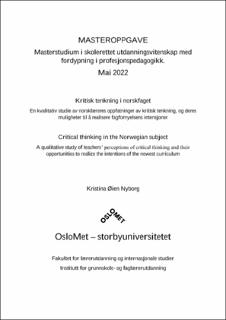| dc.description.abstract | Kritisk tenkning er nedfelt i opplæringsloven og fagfornyelsen (Opplæringslova, 1998, § 1-1; Kunnskapsdepartementet, 2017, s. 6). Sosiale medier, fake news og den massive informasjonsflyten bidrar til at mennesker trenger verktøy som lar dem møte utfordringer på en kritisk og reflektert måte. Hvordan dette kan undervises for i norskfaget, er forsket lite på. I denne studien søker jeg derfor å besvare følgende problemstilling: «Hvordan kan ungdomsskolelærere bidra til å realisere fagfornyelsens intensjoner med kritisk tenkning i norskfaget?». I tillegg har jeg formulert tre forskningsspørsmål, som tar for seg hvordan lærerne oppfatter begrepet og dets betydning i dagens samfunn, mulighetene og utfordringene lærerne oppfatter med undervisning for begrepet og hvordan vi kan forstå deres diskurs i lys av fagfornyelsen og ulike faglige perspektiver på kritisk tenkning. Studien har en kvalitativ tilnærming, og bruker semistrukturerte forskningsintervjuer. Datamaterialet er samlet inn gjennom åtte intervjusamtaler med norsklærere i ungdomsskolen. Dette utgjør empirien i studien. Ulike perspektiver på kritisk tenkning og kritisk literacy, samt læreplanteoretiske ståsted, danner det teoretiske grunnlaget for drøftingen av problemstillingen. Funnene fra intervjuene og drøftingen viser at informantene har ganske lik forståelse av kritisk tenkning, hva det innebærer og hvilken betydning kompetansen har. Likevel fremmer de ulike syn knyttet til hva som skal til for at elevene kan tilegne seg kritisk tenkning. Informantene viser til mange muligheter, der det norskfaglige og tekstlige, bruk av ulike medier som inngang, kildearbeid og bruk av muntlige undervisningsformer er mest sentralt. Likevel møter de utfordringer både i undervisningsarbeidet, og knyttet til mer strukturelle aspekter. Tendensen i studien viser at det finnes et uforløst potensial og behov for å utvikle lærernes kunnskaper om kritisk tenkning, og hvordan det kan undervises for. Samtidig vises det et behov for å gi lærerne større rom til individuell utnyttelse av eget handlingsrom. Dette er en sentral problemstilling i det videre arbeidet med å utvikle undervisning for elevenes kritiske tenkning. Studien har didaktiske bidrag til undervisning for kritisk tenkning i norskfaget. I tillegg bidrar den til å belyse hvordan kritisk tenkning oppfattes, hvilke utfordringer undervisningen kan by på og, ikke minst, hvilke utfordringer lærerne kan møte på som et resultat av den overordnede styringen.
Critical thinking is incorporated in the Education Act and the new Norwegian curriculum (Opplæringslova, 1998, § 1-1; Kunnskapsdepartementet, 2017, s. 6). Social media, fake news and the massive flow of information, contributes to people needing tools that lets them meet challenges with a critical and reflective mind. There is little research on how this can be taught in the Norwegian subject. In this study I therefore seek to answer the following issue: “How can middle school teachers contribute to realizing the curriculum’s intentions with critical thinking in the Norwegian subject?”. In addition, I have formulated three research questions which addresses how teachers perceive the concept and it’s meaning in today’s society, the opportunities and challenges teachers perceive with teaching for the concept and how we can understand their discourse in light of the subject renewal and different professional perspectives on critical thinking. The study has a qualitative approach and uses semi-structured research interviews. The data material was collected through eight interview conversations, with teachers teaching the Norwegian subject in middle school. This constitutes the empirical data in the study. Different perspectives on critical thinking and critical literacy, as well as curriculum theoretical standpoints, form the theoretical basis for the discussion of the issue. The findings of the interviews and the discussion show that the informants have a similar understanding of critical thinking, what it entails and what significance the competence has. Nevertheless, they promote different views related to what it takes for students to acquire critical thinking. The informants point to many possibilities, where the Norwegian subject and texts, the use of various media as input, source work and the use of oral teaching methods are most central. Nevertheless, they also face challenges in the work related to teaching and more structural aspects. The trend in the study shows that there is an untapped potential and need to develop teachers’ knowledge of critical thinking and how it can be taught, while at the same time there is also a need to give teachers greater room for individual use of their own room of maneuver. This is a key issue in the further work of developing teaching for students’ critical thinking. The study has didactic contributions to teaching in the Norwegian subject. In addition, it helps to shed light on how critical thinking is perceived, what challenges teaching can present and, not least, what challenges teachers may face as a result of the overall management. | en_US |
